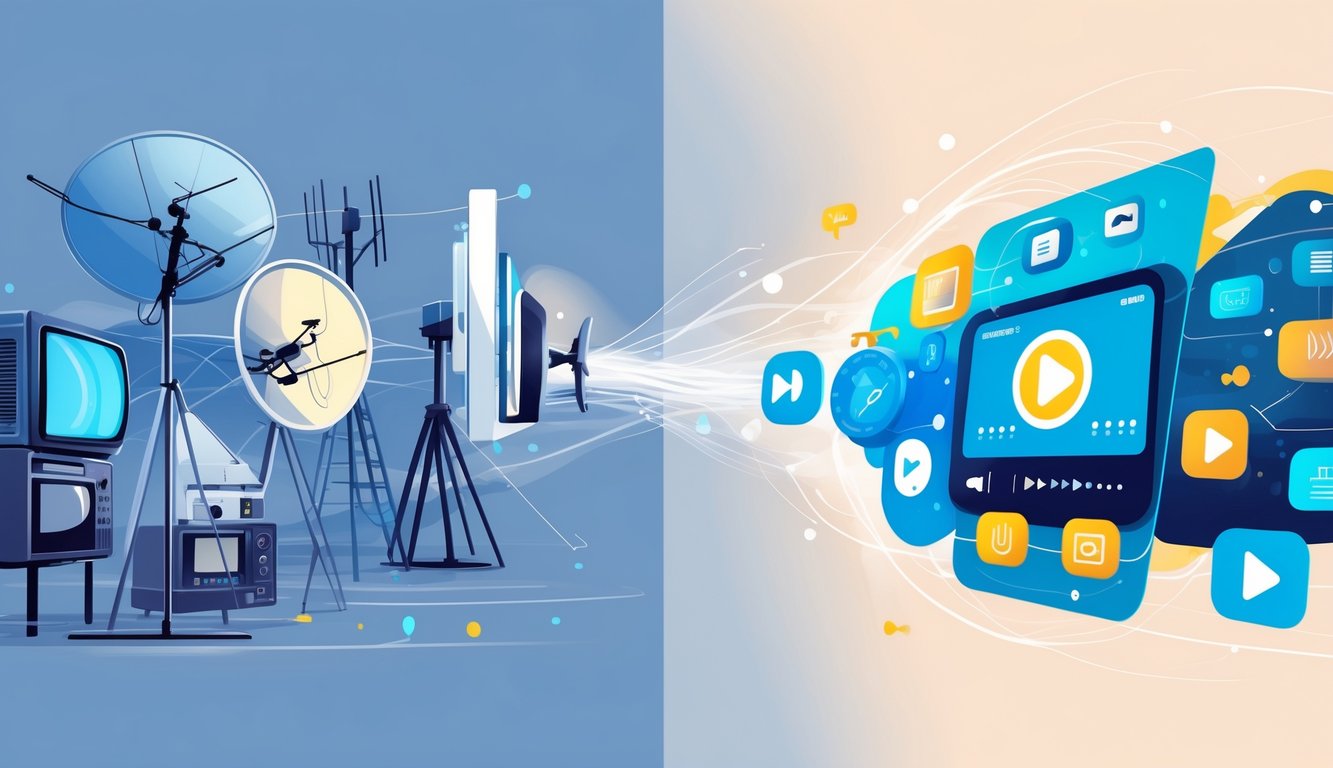
So, streaming’s crushing cable now. I mean, I barely paid attention to the headlines until someone threw out the number—streaming’s at 44.8% of all TV viewership, officially beating out cable and broadcast combined (Nielsen’s screaming about it, if you want the receipts: streaming reaches a historic milestone). Netflix’s still king, YouTube’s up 120% since 2021 (seriously, who’s watching all that, and do they have jobs?), and those “FAST” things like PlutoTV and Tubi—who actually uses those?—just keep creeping in. People used to swear network TV would never die because of sports and news. How’s that working out now?
It’s kind of hilarious watching networks—ABC, NBC, whatever—shove their best stuff onto streaming like it’s business as usual. I heard from a Universal guy (off-the-record, obviously) that their ad tech team scrambled to re-code everything the second those Nielsen numbers dropped for May 2025. Cable’s still holding 24.1% of TV time, but, like, who cares with this pace? Suddenly CBS and Fox are dropping exclusive streaming bundles out of nowhere. Thought you’d catch The Masked Singer on the same channel as always? Good luck.
Meanwhile, my neighbor’s still glued to local news for tornado updates, but networks aren’t exactly chasing that demo. NBC’s jamming Peacock ads into every break—I just wanted the score, not a sales pitch. It’s awkward, rushed, and honestly, if you read the subtext, it’s not an accident. If you’re hoping for a tidy summary, me too. While networks panic, streaming just keeps hoarding eyeballs.
The Rise Of Streaming Over Traditional Broadcast
When’s the last time I used a cable box? No idea. Streaming just kind of happened, and now it’s everywhere. Nielsen’s latest says streaming’s at 44% of U.S. TV viewership, officially steamrolling cable and broadcast. Old TV habits? Toast.
From Television To Streaming Platforms
Picture me: three remotes gone, watching Netflix on my phone because, honestly, why not? The leap from broadcast to streaming was like—blink and you missed it. Nielsen’s 2025 report just hammers it home: streaming platforms are ahead, and networks can’t keep up.
YouTube and Netflix aren’t just up—they’re dominating. YouTube’s up 120% in four years, somehow. I kind of miss the old TV static, but let’s be real: nobody’s planning their night around a show anymore. OTT made it way too easy. Even the crustiest cable brands are launching apps, trying not to get left behind like someone still mailing in Netflix DVDs.
Heard this at dinner (from someone who writes jokes for a living): networks now send licensing deals straight to Amazon or Apple TV+, skipping cable syndication. Chaos for execs, but for me? Fewer ads, binge everything, search bars, and, weirdly, less pizza since I don’t get up for commercials.
Shifts In Viewer Behavior And Demand
My niece FaceTimes while half-watching Disney+—nobody’s sitting through five minutes of shampoo ads anymore. People aren’t just impatient; literally every show is online, just waiting. Streaming outperforms cable and broadcast because, suddenly, the viewer’s calling the shots.
The “top channels” now? Playlists, algorithms, TikTok knockoffs. Networks see it and start copying—binge drops, weird on-demand windows, app-only extras. Younger viewers ditch pay TV in droves, but my dad still loses it if the news isn’t on at six sharp.
Anyone saying broadcast’s coming back is, uh, ignoring reality. Reports say 32% of new streaming users came from cable. Sometimes my stream buffers and I weirdly miss the old cable fuzz, but whatever.
Impact On Global Media Marketplace
Ever tried talking global streaming rights before coffee? It’s a mess. I was on a call with a producer in Mumbai—OTT models just blow up the old licensing rules. U.S. studios want global launches on Prime Video, which just guts the old “windowing” thing.
It’s all over the annual reports—Disney, Paramount, Warner Bros. brag about international streaming cash, but quietly admit they’re eating their own pay TV profits (shoutout to Press Maverick for digging that up). European broadcasters rush to make local streaming apps, but Netflix’s already in the door. And sports rights? Don’t even start. Streaming overlays look like arcade games now. Wild.
If you want to watch stuff worldwide, good luck with exclusives, geo-blocks, and blackout dates. But the global media market just keeps expanding, for better or worse. Chaos doesn’t kill creativity—it just multiplies confusion, and maybe, accidentally, some good shows.
How Major Networks Are Adapting Their Strategies
If network execs thought this pivot would be easy, they’ve clearly never tried explaining to their grandma why Stranger Things isn’t on her cable box. NBC, CBS—they just can’t pick a lane. Subscription? Ads? Both? They’re all-in on digital, shifting budgets, and mashing platforms together.
Changing Business Models
Old playbooks? Out the window. Ever seen a cable company so desperate they offer “free” streaming for a year if you stick around? It’s getting weird. It’s not just about prime time ads or syndication anymore; every network’s hustling direct subscriptions like we all want another password to forget. CBS keeps rebranding All Access as Paramount+—like, do they think we’re not paying attention?
Ads are a circus now. Hulu and Peacock push “free with ads, premium if you pay,” and nobody blinks. Nielsen’s latest says streaming’s at 44.8%—decades of broadcast/cable dominance just trashed. Broadcasters hype originals like their lives depend on it—probably because they do.
Forming Digital Partnerships
Football in 2025? What a mess. NFL games are on Amazon, sort of on Fox, and viewers are everywhere. These digital “partnerships” aren’t cute—they’re desperate. Disney+ bundles with Hulu, NBCUniversal fights for Roku, Apple TV+ does weird, hidden deals you only find if you ask Siri the right question. It’s not about teamwork. It’s survival. Internet providers, cable companies, tech giants—they’re all elbowing in, slicing up revenue, and TV execs no longer run the show.
Adapting To Multi-Screen Viewing Habits
I can’t pretend I’m not part of the problem—my phone’s blowing up while a sitcom hums in the background. Networks know it, too. They’re all-in on “second screen” extras, companion apps, hashtags, shoving bonus content at you mid-episode.
You’d think they’d have this figured out, but I still get random app alerts pitching web shorts while I’m watching something else. ESPN’s app freezes right in the middle of highlights. Cable companies even give away tablets now, just to keep you locked in. Tech headaches aside, my attention’s the product. Networks want it, you want it, and if you’ve ever tried voting on a live finale from your smart fridge, you know it’s everywhere.



